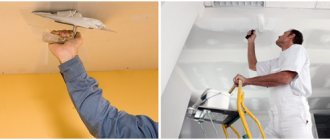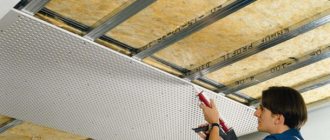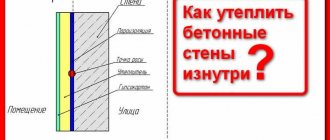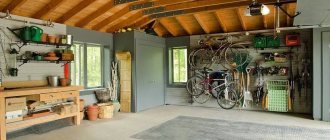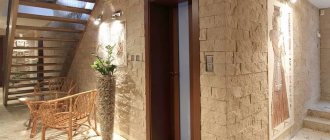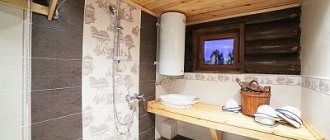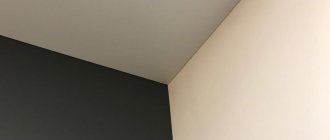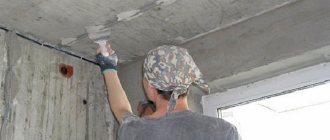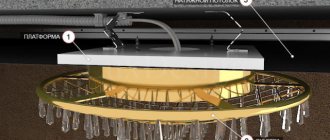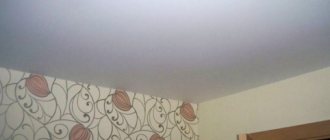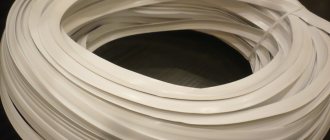assets/from_origin/upload/resize_cache/iblock/abd/600_450_2/abdabfd906fdab67f8f5e05eeb9dcab2.jpg From this article you will learn:
- How to choose the right materials for ceiling finishing
- What modern materials exist for finishing the ceiling?
- How to choose materials for finishing the ceiling depending on the functional purpose of the premises in an apartment or private house
When undertaking renovations in your home, you need to be prepared for the fact that one of the most labor-intensive stages will be finishing the ceilings. And what materials will be used to finish the ceiling is a key question. A detailed answer to this can be found in this article.
Whitewash
When whitewashing ceilings, the following compositions are used:
- Cretaceous. They are not waterproof, but will allow you to achieve excellent aesthetics of the ceiling.
- Calcareous. They are highly resistant to moisture, the spread of fungus and mold, but do not have sufficient whiteness after application.
The listed mixtures are inexpensive and can be used by anyone who wants to refresh the ceiling.
To achieve the optimal concentration of the mixture, you need to perform a series of sequential actions:
- Fill a 5-liter bucket with warm water;
- Dilute 100 g of wood glue in a container;
- Add 3 kg of sifted chalk powder (pre-sifted);
- Add 10-20 g of blue to increase whiteness.
Constant stirring when adding components is necessary. The resulting solution will be enough for 10-12 m² of surface.
It is easy to check the quality of the resulting composition. The knife is lowered into the bucket up to the handle. If a thin, even layer of whitewash without lumps remains on the blade, then the solution is ready for use. Now you will need a brush or sprayer (compressor, spray bottle). The sprayer will allow you to apply whitewash evenly to the ceiling.
Before performing work, you must wear personal protective equipment - gloves, mask, goggles.
The ceiling must be carefully prepared. Remove the old layer of whitewash using a damp cloth or brush. Level the ceiling using putty. After the mixture has dried, sand the surface with sandpaper. At the final stage, apply a deep penetration primer and wait 20-24 hours.
Pros:
- Use of environmentally friendly materials;
- The most budget-friendly way to refresh the ceiling;
- The work is carried out without the help of specialists;
- Does not visually reduce the height of the ceiling.
Minuses:
- Long preparation for using the composition;
- Considerable labor intensity of work;
- Limited selection of shades;
- After 4-5 years, whitewashing loses its basic properties.
Liquid wallpaper
The modern market of finishing materials offers lovers of stylish interiors various options for liquid wallpaper.
Original adhesive-based decor is conventionally classified as decorative plasters. It looks good in residential, office and administrative premises.
The finishing composition includes texture additives:
- glitter;
- microgranules;
- fibrous structures;
- textile components;
- cellulose flakes.
The list of common coatings includes:
- silk-cellulose;
- cellulose;
- cotton;
- silk.
The length of the service life is affected by the percentage of humidity in the room and other factors.
Preparing the ceiling for applying liquid wallpaper, in general, does not differ from similar work before applying traditional plaster:
- The previous decorative layer is removed;
- The surface is puttied and primed.
The powder composition must be diluted according to the instructions and applied to the surface with a grater or spatula. To increase durability and water resistance, designers advise decorating the dried layer with a paint coating.
pros:
- Relatively low cost;
- Attractive decor;
- Good adhesion;
- Restoration of damaged areas;
- Convenient layer leveling.
Minuses:
- Not recommended for use in rooms with high humidity;
- In order to increase the service life, it is necessary to apply a layer of varnish;
- Long drying process – up to 72 hours.
But when applying liquid wallpaper, minimal preparation is required when it comes to finishing the ceilings.
Suspended structures
Their essence is the installation of fasteners into walls or ceilings onto which coating plates are attached (or simply laid). Most often they are square or in the form of long stripes, but other geometric shapes are also possible. The main materials are plastic, metal, drywall. The main advantages include:
- Possibility of use in any room;
- variety of textures, colors, types of coating;
- suitable even for curved ceilings with interpanel seams that cannot be masked;
- excess wires can be hidden under the coating, making it possible to install built-in lamps and develop individual lighting schemes.
There are also disadvantages. Thus, hanging structures “eat up” part of the height of the room, which can be sensitive for small rooms. An accurate calculation of the geometry of the fastenings is also necessary.
Painting the ceiling
One of the options for budget decoration of the ceiling is the application of a coloring composition:
- silicone;
- latex;
- acrylic;
- water-based.
Each solution has advantages, disadvantages, cost, and method of application.
Preparing the ceiling for application of paints and varnishes is carried out in the usual manner:
- The old topcoat is removed;
- The ceiling is plastered and primed.
The paint is prepared for use in accordance with the instructions. On the ceiling, the solution is applied using a roller, but the presence of a spray gun can significantly speed up the process.
Under normal conditions, the coloring composition will dry within 24-30 hours.
Plastering
Decorating the ceiling with plaster mixtures is also a fairly popular procedure. Using this material you can not only decorate the surface, but also level it. In addition, plaster compositions do not burn and do not support combustion, do not emit toxic substances, and are relatively inexpensive.
Important! Such work requires two people, as well as some experience - it will be difficult for a novice home craftsman to do everything perfectly smooth.
Finishing the ceilings in an apartment with plaster is impossible if the ceiling is more than 5 cm thick. Too large a layer of material can significantly reduce the service life of the coating. In addition, the plaster “steals” the height of the walls a little.
Decorative plaster
The list of decorative plasters: structural, textured is quite large and choosing the most successful type of finishing is not easy. The key feature of finishing cladding is the creation of delightful, original patterns. For example, Venetian plaster is famous for this advantage.
Decorative plaster is mainly sold in the form of dry mixtures. During the preparation process, the powder compositions are mixed with water with the addition of the necessary microgranules in order to ultimately achieve an extraordinary texture on the ceiling. The finishing materials market offers the following decorative plasters:
- Sea breeze . Creates the effect of a light breeze, looks beautiful in a traditional, sophisticated interior;
- Wet silk . Imitates natural silk fabric due to mother-of-pearl particles;
- Latex plastic . The decorative material forms an original glossy texture on the ceiling;
- Craquelure . Using a heterogeneous composition it is easy to achieve the impression of an aged surface;
- Sgraffito . Creating interesting patterns by scratching or cutting on a paint surface.
- Marseille wax . Deep relief will allow you to achieve abrasion reminiscent of the Provence style;
- Venetian plaster . Once applied to the prepared ceiling, the decor is able to most accurately reflect the marble effect;
- Mosaic . Excellently creates the illusion of a mosaic, due to fine-grained stone inclusions and colors;
Structural plasters are made on the basis of mineral, polymer components: solid fractions of stone, sand, mica, quartz, wood fibers, potassium silicate, cement and lime. The coating fits well on concrete, wood, plasterboard, and stone surfaces.
Decorative plasters are conventionally divided into several categories.
- Silicone . Good vapor permeability, durability and quick way to use.
- Acrylic . They are combined with mineral bases, characterized by high elasticity and low cost.
- Silicate (with liquid glass) . They can be used immediately after purchase, they are durable and resistant to interaction with water.
Mineral decorative coatings made with the addition of cement and gypsum are positioned as environmentally friendly, fireproof, and excellent adhesive properties.
Work on preparing the mixture for application to the ceiling varies depending on the choice of decorative plaster. When removing the old coating and decorating the surface with a new layer, the following tools are used:
- crest;
- putty knife;
- sponge;
- grater;
- ironer;
- sandpaper.
To achieve excellent results, decorators often use a building level.
Keeping decorative plasters clean is easy. Most finishes will not be damaged by the use of soap and water.
pros:
- The unique aesthetics are amazing;
- Ceilings in bathrooms are decorated with certain types of decor;
- There is no need to carefully level the base;
- A large selection of color shades will allow you to choose plaster for your interior.
- Long service life.
Minuses:
- If the work of applying decorative plaster is being carried out for the first time, it is advisable to use the help of experienced decorators;
- The purchase and application of some finishing claddings will cost a pretty penny;
- Removing decorative plaster, if necessary, will require a lot of time and physical effort.
Grilyato
“Grigliato” refers to a system in the form of a lattice, with the help of which it is convenient to decorate ceilings in large rooms. This refers to restaurants, exhibition halls, shopping centers and pavilions - that is, all those areas where it is necessary to comply with fire safety standards, provide quick access to communication systems and give the premises an interesting design.
Structurally, the Grilyato suspension system is a grid made of aluminum profile. Wide possibilities for design solutions are provided by applying coatings of different colors and shades. The convenience of Grilyato also lies in the possibility of combining it with other suspended ceiling systems. The combination with plasterboard ceilings makes it possible to create multi-level structures of various configurations.
There are several types of Grilyato ceilings:
- Standard . A flat finish built parallel to the floor. For this, a U-shaped profile is used. The most inexpensive and easiest to implement variety.
- Blinds . This lattice is distinguished by a significant cell density. With the help of this most invisible type of Grilyato, you can achieve good camouflage of the rough foundation and the communications laid there.
- Pyramid . To create gaps in the form of truncated pyramids, a Y-shaped profile is used. The result is a visual expansion of the room space and an unusual perspective effect. This opens up additional opportunities for interesting play with space in cases where the rough ceilings have a non-standard shape. We are talking about slopes, attics, polygonal and multi-level floors.
- Multi-level system . Has the greatest potential for realizing design ideas. This is facilitated by the presence of profiles of different heights and shapes, thanks to which any room can be transformed beyond recognition.
The popularity of Grilyato ceilings in the design environment is also explained by the possibility of using unusual ceiling lighting. This creates original visual effects, play of shadows and light highlights, significantly expanding the use of this suspended ceiling option.
Strengths of Grilyato ceilings:
- High speed of installation work, during which there is practically no dust and dirt.
- Hydrophobicity.
- The space between the concrete floor and the decorative surface is well ventilated.
- Low cost.
- Ensuring solidity of the coating. Due to the absence of visible joints, the ceiling system appears continuous.
- Possibility of quickly replacing broken elements.
- Wide selection of colors and textures. The surface of Grilyato can be matte, glossy, pearlescent, chrome, etc.
- The ability to create original lighting effects and accents by installing lamps above the surface of the grille, outside or inside it.
Among the weaknesses of Grilyato, one can highlight its visually visible design. This causes known difficulties when masking the ventilation system, wires and cables.
Drywall
You can stylishly decorate the ceiling using plasterboard sheets. The thickness of each material should not exceed 7-10 mm. Drywall consists of double-sided construction paper and gypsum mortar in the middle.
After installation is completed, facing decor is used: tiles, self-adhesive films, paints and varnishes, traditional wallpaper, plaster mixtures.
Main types of plasterboard sheets:
- Moisture resistant . It is recommended to use the material in rooms with high humidity;
- Fire resistant . Installed in cottages, country houses and premises that are subject to strict fire safety requirements;
- Traditional . Installed in residential apartments.
Installing plasterboard sheets will require a lot of time, some experience and the help of specialists, especially when you plan to create a two-level or multi-tiered structure.
First, a steel sheathing is mounted to the surface, and then the finished frame is sheathed with panels.
This method will visually eliminate uneven ceilings and all kinds of defects. During the work process, it is easy to achieve a unique decorative coating by creating rounded corners, interesting shapes and arranging niches.
Keeping drywall panels clean is extremely easy. Housewives usually use a sponge or a dry viscose fiber cloth. To get rid of dust in the corners, use a vacuum cleaner and special attachments with hard bristles. The resulting stains are removed with a soap solution or detergents without abrasive particles.
Pros:
- High aesthetics;
- Long service life;
- Variability in achieving stylish decor;
- Masking defects in ceilings;
- Possibility to install lamps.
Minuses:
- Quite complex installation;
- A partner's help won't hurt;
- Deformation and color change over time;
- Visual reduction in ceiling heights.
It is better to do beautiful decor a year or two after putting the house into operation, otherwise there is a high probability of defects appearing on the plasterboard sheets.
Floor preparation
Before finishing the ceiling in a private house, you need to prepare the base surface and the entire ceiling. Unlike an apartment in a high-rise building, the ceiling of a private house requires additional insulation and protection from condensation and moisture.
That is why before finishing the ceiling cladding, take care of the following:
- lay thermal insulation material between the floor beams (this is especially important if there is an unheated attic above);
- a layer of vapor barrier is laid above the ceiling to ensure the removal of condensate that accumulates in the thermal insulation material due to temperature changes;
- Below the insulation, a layer of waterproofing is attached to the beams, which will protect the structure from moisture evaporating from the room and rising upward.
Stretch ceiling
The common decor is made of polyvinyl chloride, synthetic fabric and is stretched over the entire area of the ceiling, forming an even, smooth, beautiful surface. Strong, durable, waterproof PVC film is used to cover ceilings even in kitchens and bathrooms.
Glossy, satin and matte products in various color tones are made from vinyl canvases. Achieving original decor will be possible using photo printing, when an image is applied to the surface: a drawing, pattern or imitation of other materials - metal, mirrors, etc. The finishing will provide the opportunity to create a multi-level structure in the room.
Fabric sheets for ceilings are made from polyester fibers and impregnated with polyester. One of the disadvantages of this material is the meager choice of color shades compared to vinyl stretch ceilings. The list of advantages includes the ability to tint the coating several times, and a big plus is its resistance to low temperatures.
Designers often use perforated two-layer material. The upper canvas acts as a background, and the lower one is cut to imitate patterns and geometric shapes. In order to enhance visual perception, light bulbs are installed to create tonal illumination. If there are noisy neighbors upstairs, it is recommended to install suspended ceilings with a soundproofing effect. It is advisable to install a film with antibacterial properties if relatives with weakened immune systems live in the apartment.
Keeping PVC tension threads clean is easy. Usually a soap solution or non-aggressive household chemicals are used. Fabric fabrics require careful care:
- Do not use wet cloths to prevent streaks;
- Remove stains immediately;
Another recommendation is to systematically vacuum the decorative surface. It is not advisable to install fabric ceilings in bathrooms and kitchens. Reliable PVC films are produced by the following companies:
- Barrisol (France).
- MSD (China).
- Renolit (Spain).
- Extenzo (France).
- Saros Design (Estonia).
- Lackfoline (Germany).
If your neighbors are flooded, it is recommended to contact the organization whose specialists installed the coating. They will drain the water and return the material to its original state.
Installation of decor will require auxiliary materials, tools, effort, time, and therefore it is recommended to hire a team of professional craftsmen.
Pros:
- High aesthetics;
- Fast installation by experienced workers;
- Creation of exclusive design;
- Operational life two decades;
- Preservation of attractive color for 10 years;
- Possibility of restoration work;
- Minor visual reduction in ceiling height up to 3-5 cm.
- Suspended PVC film will withstand water pressure up to 100 l/m².
Minuses:
- Decrease in fabric elasticity from -5°C;
- Low-quality products release dangerous toxins;
- Difficulty installing lighting fixtures;
- High cost of installation work;
- Specific smell in the first few days;
- If handled improperly, the material can easily be damaged.
Metal slatted ceilings
First, a metal sheathing is attached to the ceiling. Then the suspended structure is sheathed with steel sheets - aluminum or copper. Enamel is used as a finishing coating. The original decor is versatile and looks great in any room:
- in the bedroom;
- In the kitchen;
- In the living room;
- On the balcony;
- In the bathrooms.
Slatted ceilings are often installed in rooms of private houses and cottages.
Depending on the degree of installation, the structures differ:
- Closed . The slats are laid end-to-end and look like lining;
- With a gap. A small distance is left between the slats for installing decorative strips.
An inexperienced person may not be able to cope with the task. To do everything right, you need to purchase: materials, tools, metal profiles. Therefore, if you lack the skills, it is recommended to hire professional workers.
The cleanliness of slatted ceilings is maintained using household chemicals (without abrasive particles) intended for cleaning glass.
Pros:
- Great style;
- Modern design;
- Fire safety;
- Possibility of decoration in various shades
- Insensitive to humidity.
Minuses:
- Possible patina formation;
- Actual and visual reduction in ceiling height;
- High cost of decoration and work.
The completed finish looks cold and attracts the attention of lovers of rebellious styles in the interior.
Recommendations for choosing finishes
When choosing the material and method of ceiling installation, you should take into account the height of the room and existing surface defects. Lighting plays an important role, affecting the visual increase or decrease in the height of the room. When choosing a ceiling finish, you need to adhere to moderation in color scheme. The upper part of the room should be in harmony with the overall style of the room.
To finish the ceiling surface in the gazebo, you can use wood lining. The bathhouse can also be decorated with such material. For covering the ceiling space in the corridor, suspended ceilings, liquid wallpaper, and polystyrene tiles are suitable. When deciding how to decorate the ceiling on the veranda, it is recommended to give preference to plastic panels or slatted aluminum profiles. In the hallway, you can decorate the ceiling using a plasterboard structure or decorative plaster.
Glass and mirrors
In recent years, the number of citizens who want to decorate their ceilings with beautiful mirrored glass panels has increased. They bring colorful variety to the living space and symbolize the high wealth of the owner of the living space.
Glass panels are made from frosted or plexiglass. It is easy to build a multi-level ceiling and install lighting fixtures using modern material. Properly organized lighting will allow you to achieve amazing beauty and style indoors. Securely secured glass panels are resistant to minor impacts and will last up to 60 years.
Modern facilities produce an assortment of glass panels. They come in square, rectangular, painted in various shades and are mounted on a metal frame in different ways, depending on the design. Due to the great variability, it is easy to create stunningly beautiful colored stained glass windows or a chaotic, multi-colored pattern on the ceiling.
The creation of mirrored ceilings follows a similar principle, only the surface of the reliable panels is pre-decorated with self-adhesive film with a characteristic gloss. The exception is ready-made solutions with a reflective effect or mirror tiles. Keeping the elements of the ceiling structure clean is not difficult. Light cleaning using a damp cloth and soapy water will suffice.
Pros:
- Impeccable interior aesthetics;
- Resistance to high humidity;
- Relatively easy way to care;
- Possibility to decorate the ceiling in the bathrooms.
Minuses:
- High price of materials, plus the cost of work;
- If cleaning is poor, stains will be visible on the glass or mirror surface;
- Working with fragile panels is quite difficult.
- Not everyone perceives mirrored ceilings as a stylish decor
- Many people find it unpleasant to look up at their reflection.
Drapery of suspended ceilings
It is easy to improve the traditional design of the ceiling if you make drapery from fabric. It is necessary to purchase, upon request, textile products:
- Organza;
- Veil;
- Brocade;
- Jute;
- Silk.
The main condition for stylish decor is the presence of characteristic folds. But it should be remembered that such an environment looks most justified in classic interiors.
To create an amazing design, you can use one of the following methods:
- Glue the material to the ceiling slab in several places;
- Mount the frame, stretch the fabric, creating folds;
Another solution is to sew Velcro tape onto the fabric and secure it at the top, at several points.
High demands are placed on the fabrics used:
- Resistance to dirt and high humidity;
- Low sensitivity to sunlight;
- Easy to maintain cleanliness;
- Sufficient elasticity.
In case of heavy dusting and darkening, textile products are removed and washed by hand. An important point should be taken into account during installation.
Pros:
- Masking ceiling defects;
- Highly stylish;
- Relatively low cost of decor;
- Ability to create lighting;
- A slight effect of space zoning.
Minuses:
- Fading over time;
- Water permeability;
- Absorption of odors.
If there is significant damage, the entire canvas will have to be replaced.
Eco-materials
It is easy to achieve a highly aesthetic ceiling using environmentally friendly materials:
- Bamboo wallpaper;
- Cork panels;
- Mats made of hemp, seaweed, sisal, cattail, etc.
These eco-materials are glued to the ceiling using adhesive solutions that do not contain water or liquid nails.
The main advantage of using the listed materials is the ability to achieve environmental cleanliness in the room. It is impossible not to notice the high degree of originality of modern decor, which improves the visual perception of ceilings and increases the style of the interior. Eco-materials ensure air circulation and do not emit toxins hazardous to health. Another distinguishing factor is easy cleaning with a dry cloth.
Pros:
- the ability to achieve environmental cleanliness in the room;
- originality of modern decor;
- provide air circulation and do not emit toxins hazardous to health;
- Easy cleaning with a dry cloth
Minuses:
- Low resistance to humidity;
- High price;
- Labor-intensive installation;
- Sensitivity to solar ultraviolet radiation;
- A limited range of colors;
- Absorbs odors.
Adhesive
Ceilings consisting of panels glued to a rough base are also considered suspended. Their history of use goes back decades, and the popularity of this budget finish is explained by its low cost and ease of installation.
Classification of adhesive ceiling tiles is carried out according to the method of their manufacture:
- Stamped . The most inexpensive variety with a thickness of 8-15 mm. It can be decorated with a relief pattern or be smooth. Good for painting.
- Extruded . The thickness of such tiles is reduced to 3-4 mm. Typically, this suspended ceiling with a pattern is laminated and has a well-defined texture (imitation metal, wood, stone, etc.). Extruded boards are characterized by excellent resistance to moisture. For this reason, it can often be found in kitchens and bathrooms.
- Injection . During the manufacturing process, the slabs are sintered from expanded polystyrene. As a result, the material has a smooth surface with a thickness of 6-8 mm.
Glue ceilings are a fairly simple finishing option that does not provide much scope for design ideas. This explains the fact that they are an order of magnitude inferior to many other solutions in terms of external efficiency. However, this does not prevent the material from having a number of other advantages - low cost, simplicity and cleanliness of installation, low weight, and the possibility of applying additional painting during operation.
